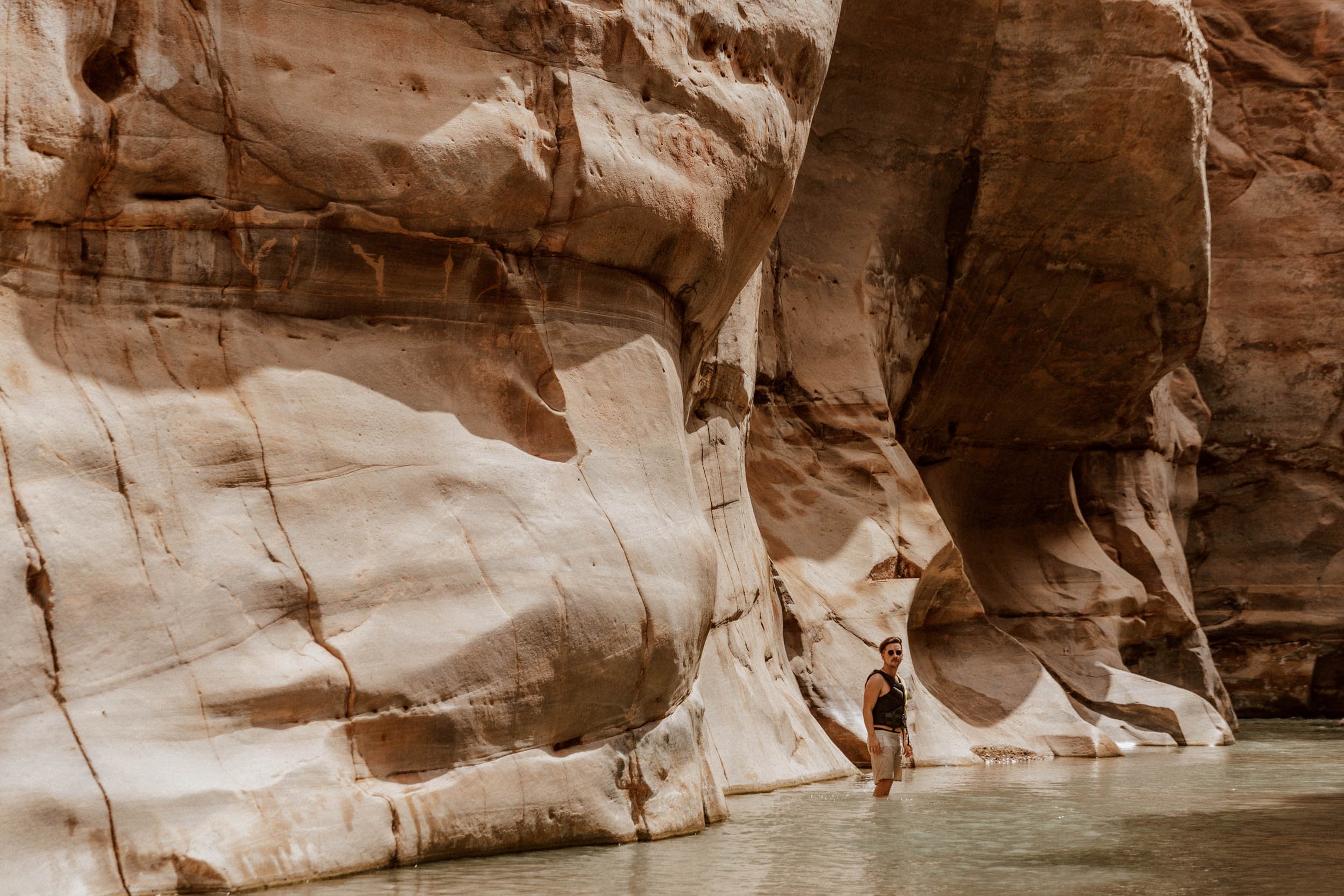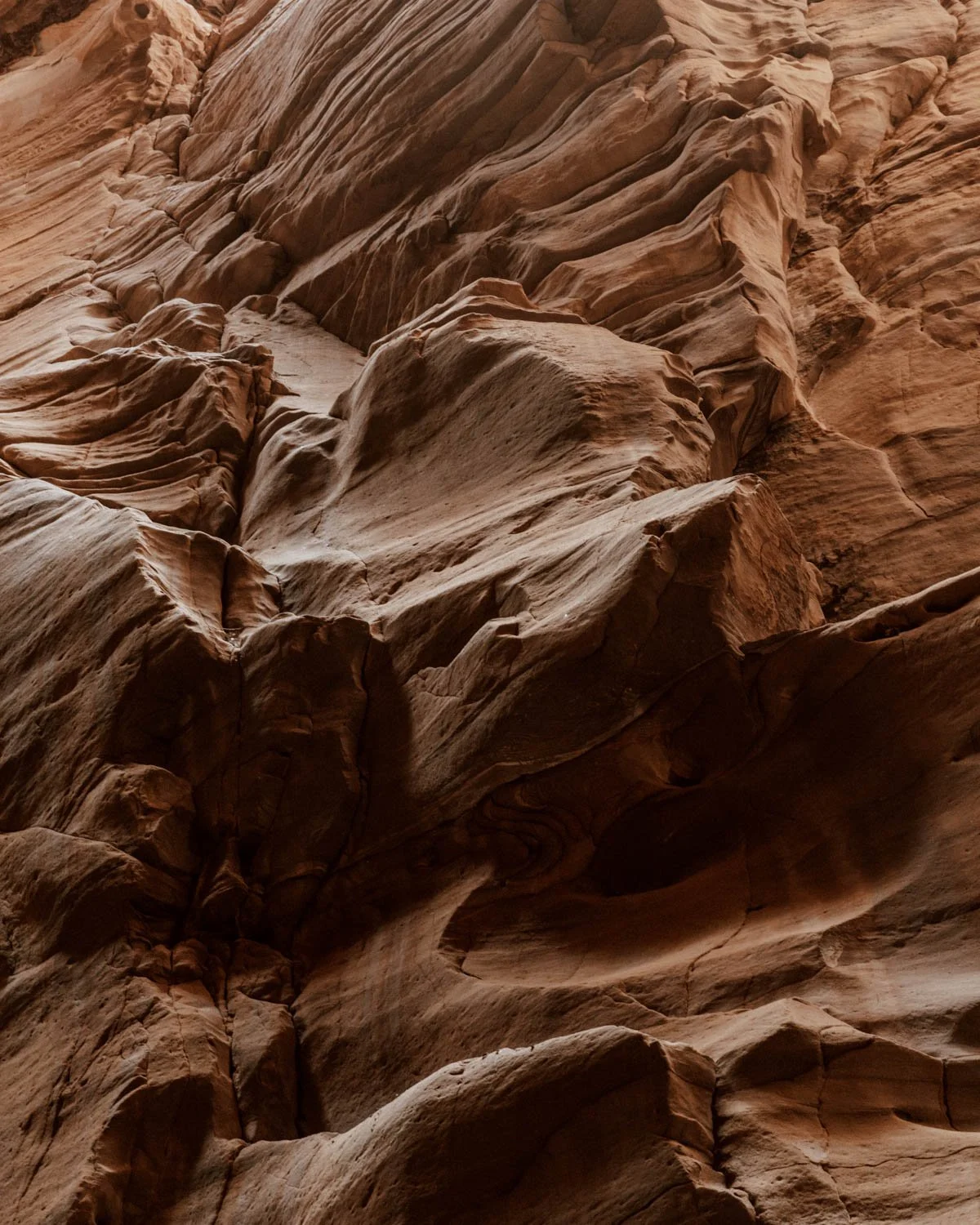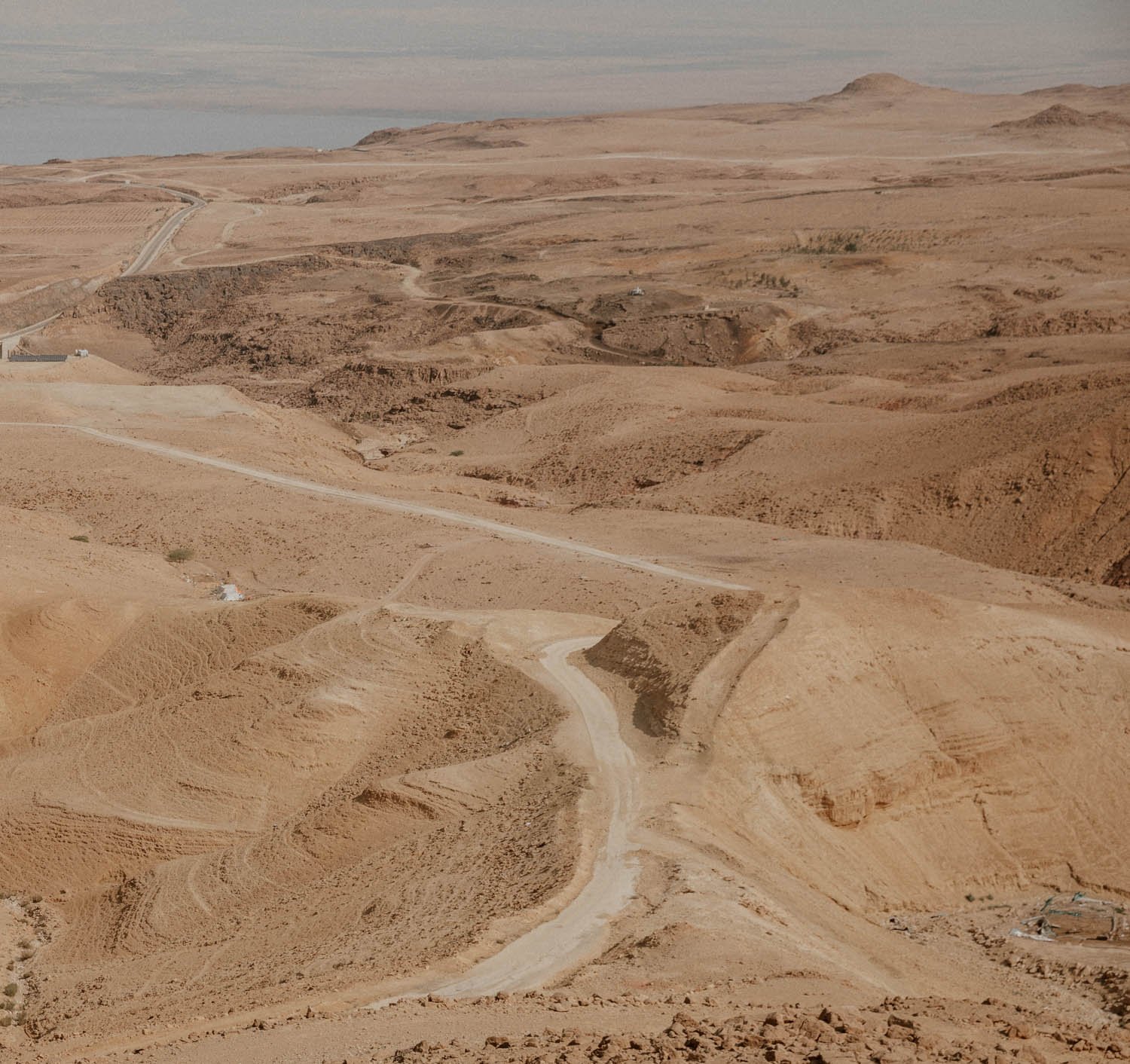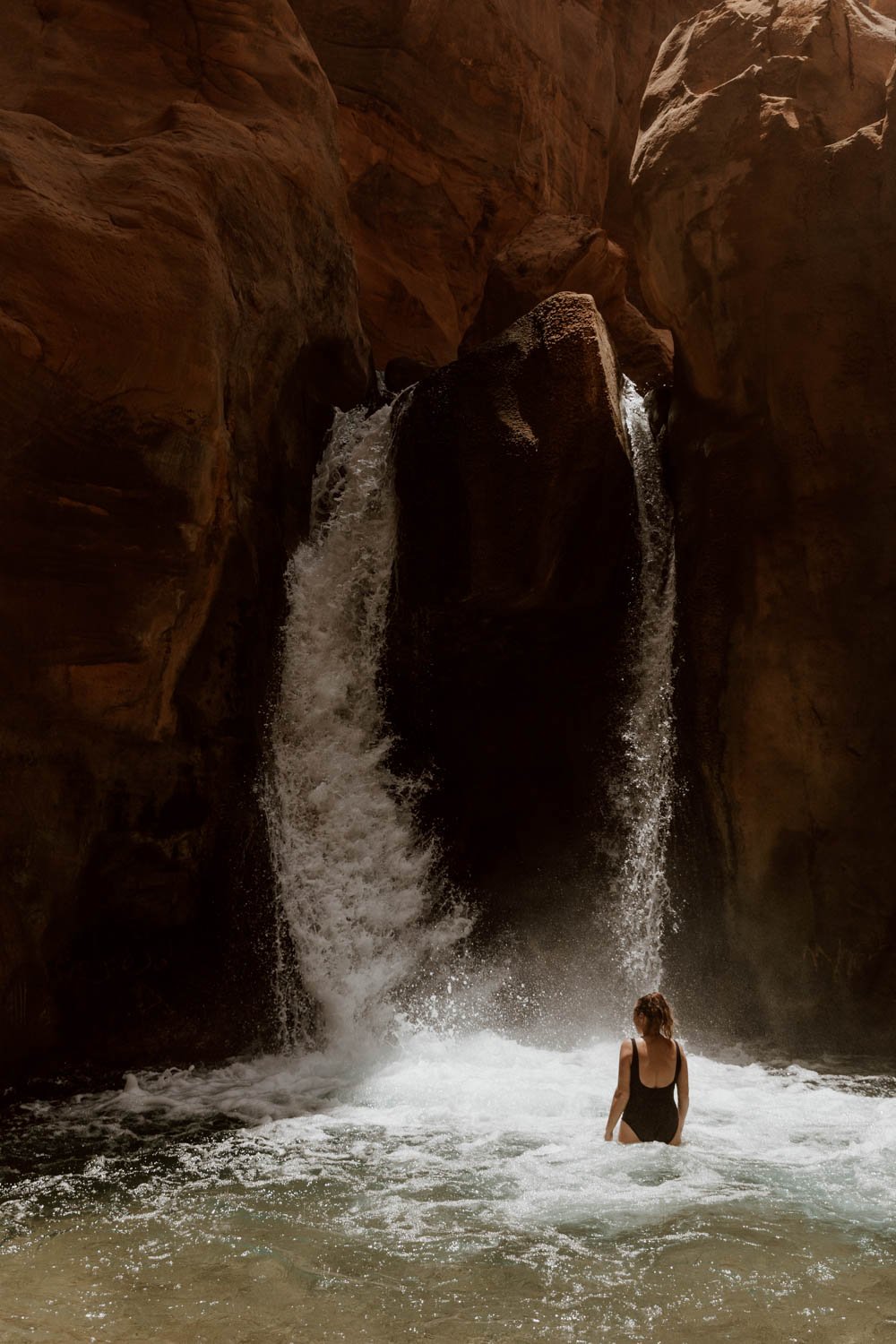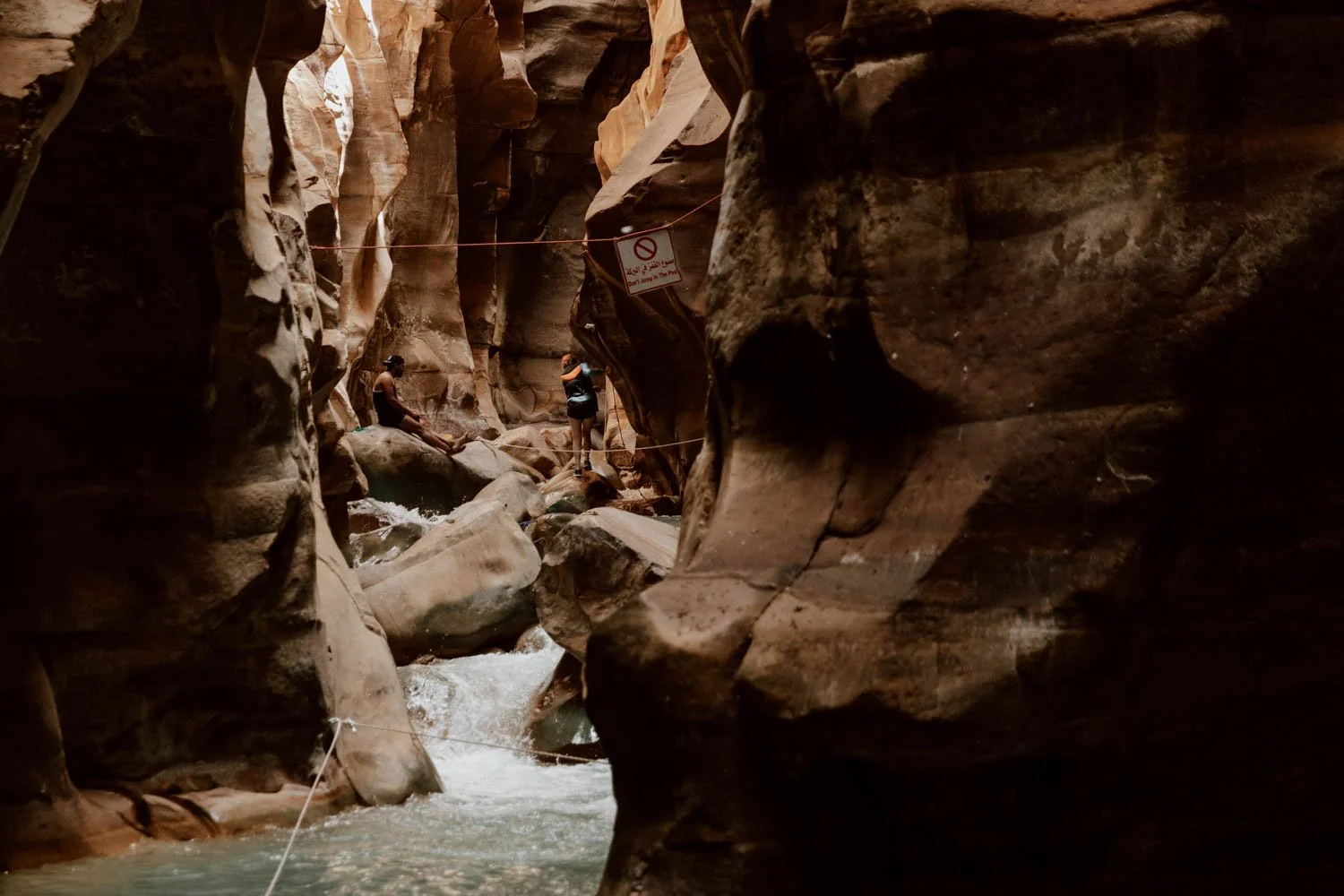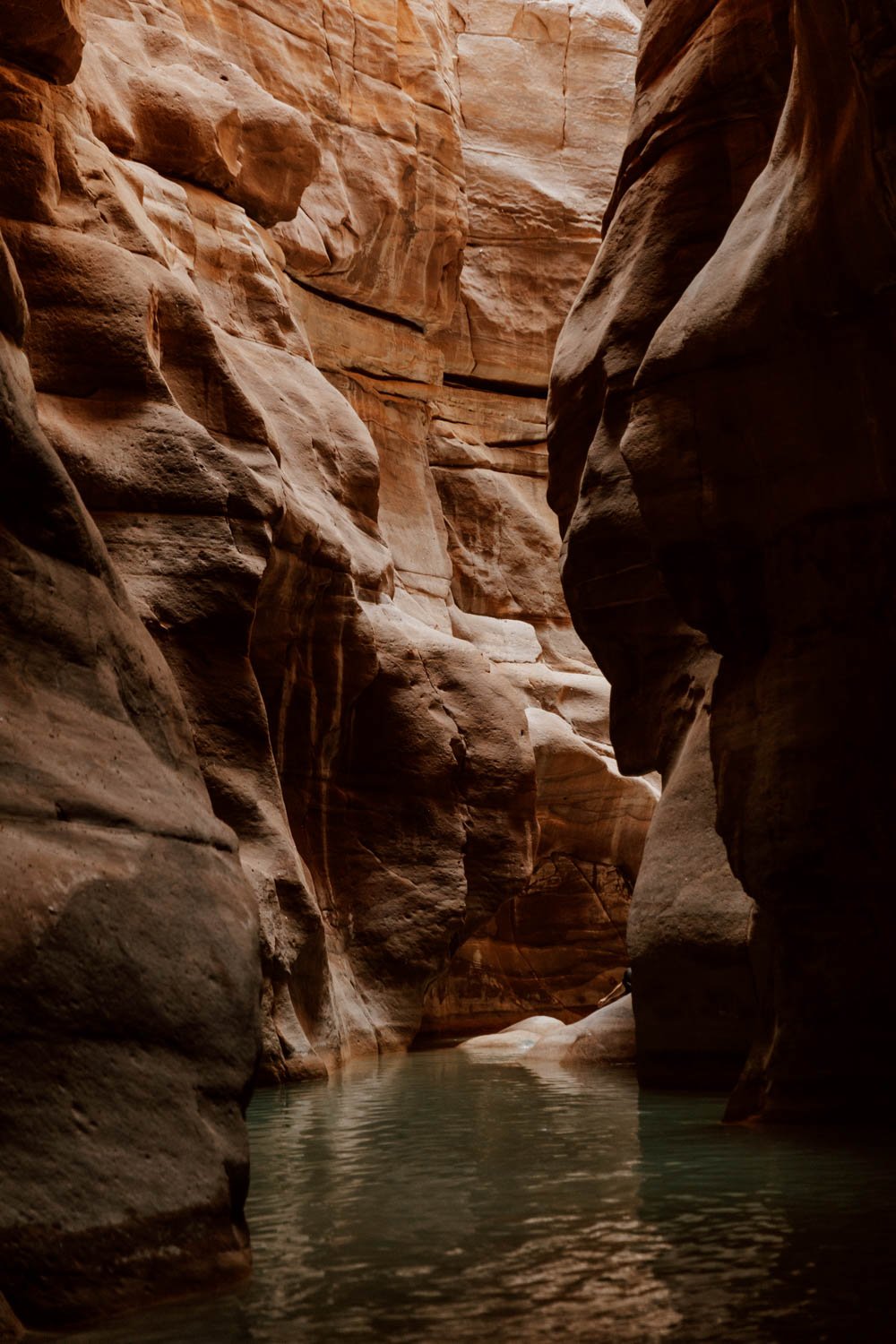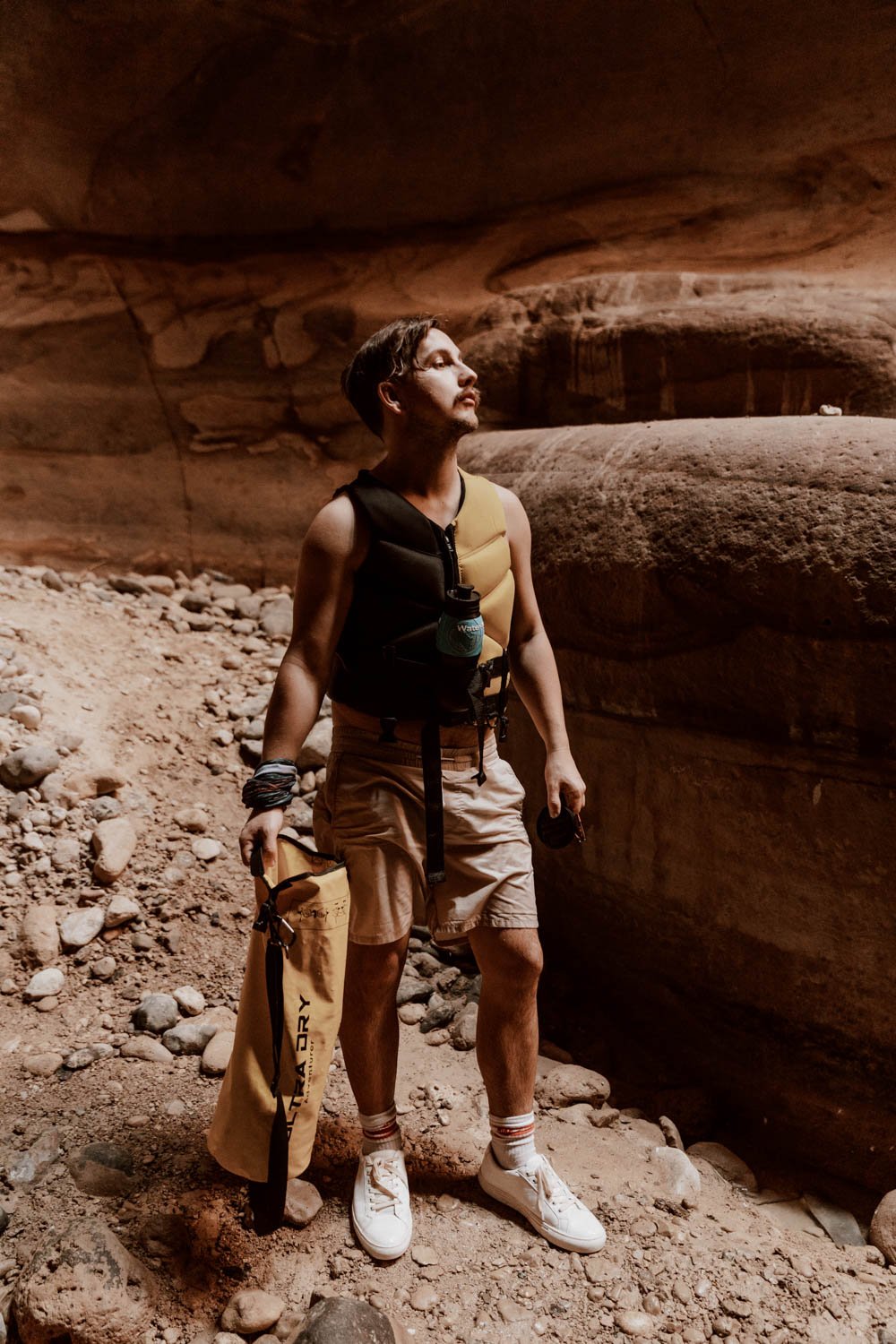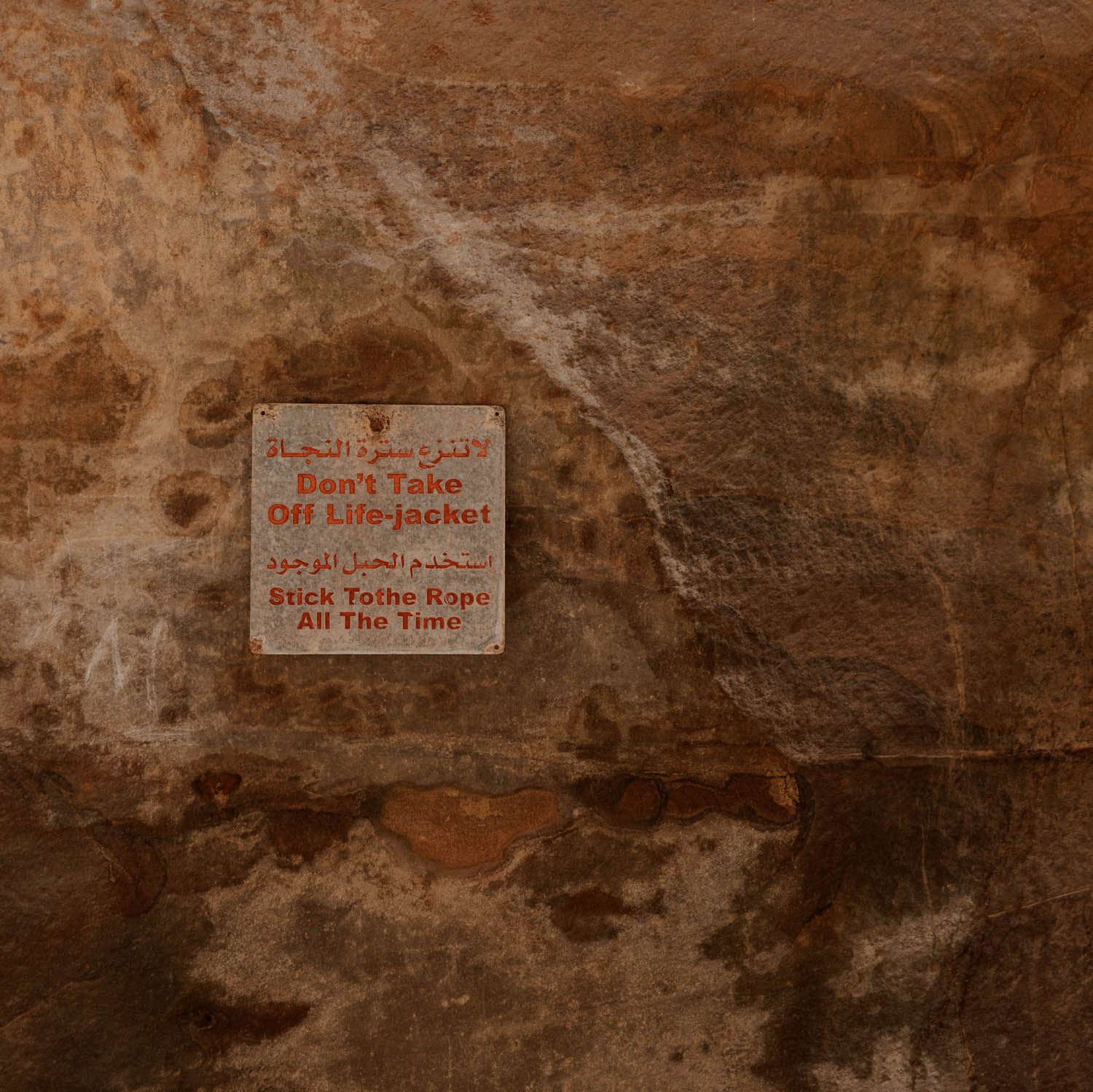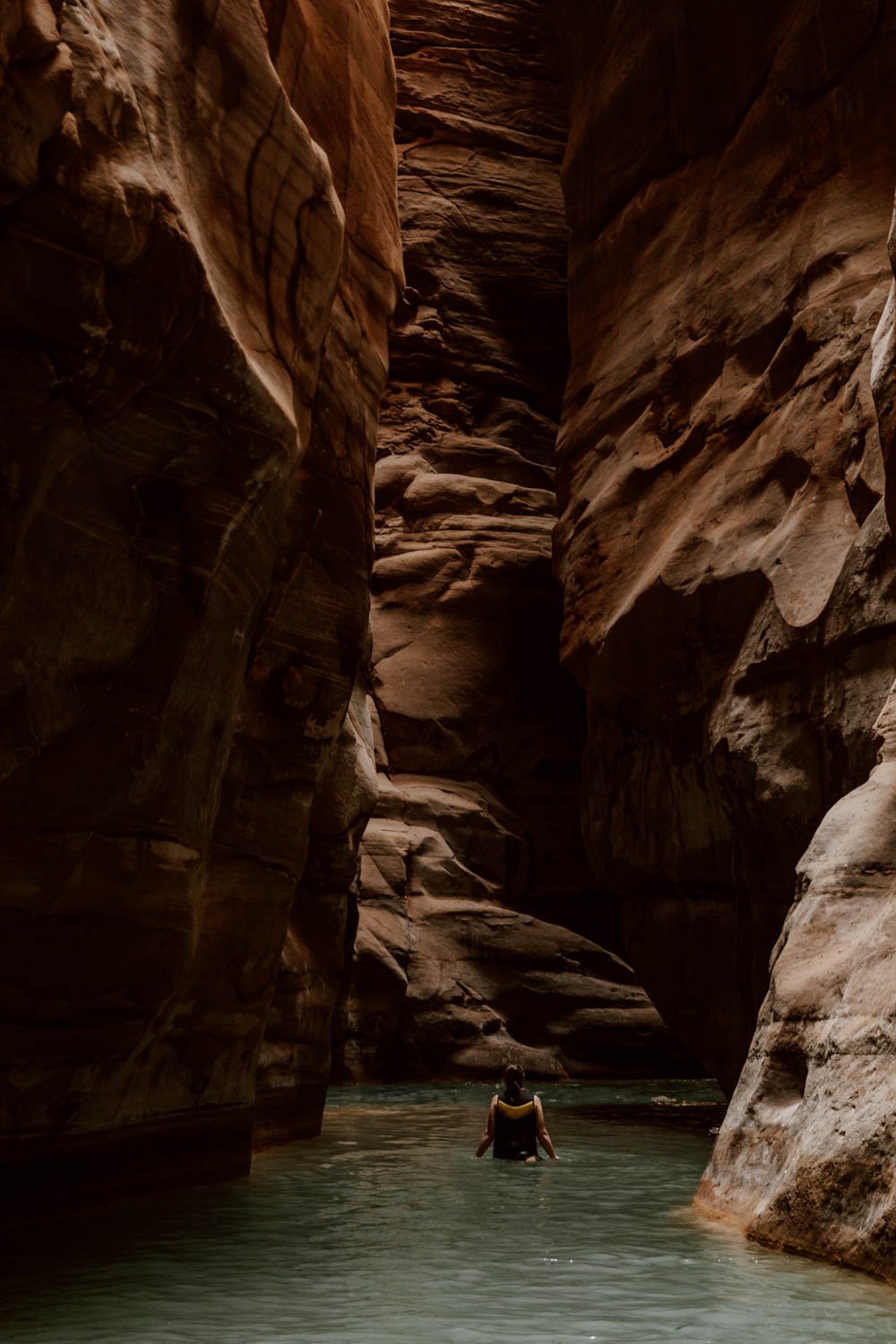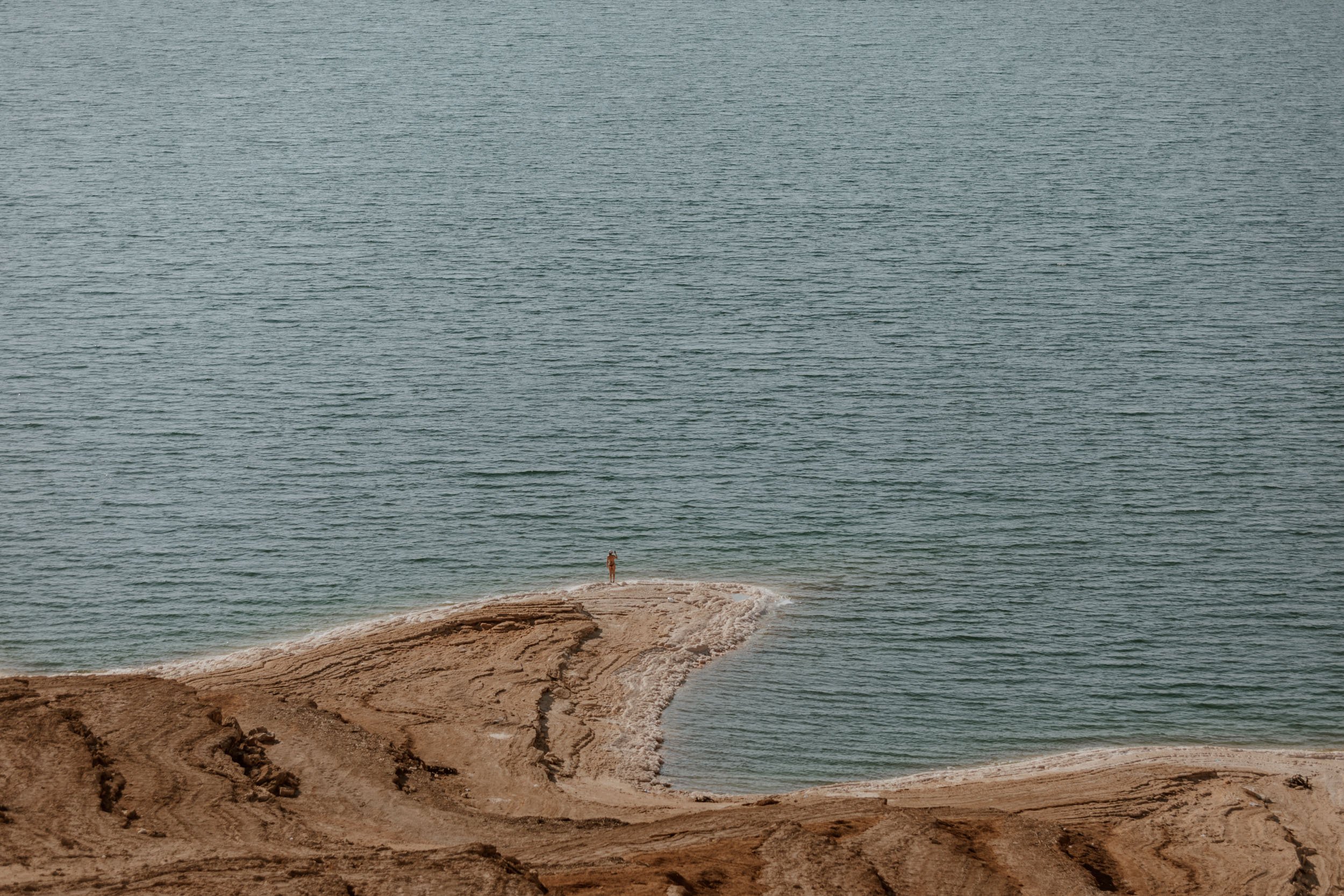We had so much fun canyoning in Wadi Mujib and highly recommend adding it into your Jordan itinerary. Discover everything you need to know to plan your visit in this guide!
“In the empire of desert, water is the king and shadow is the queen.”
Waterfalls weren't really part of the plan for Jordan.
This land is one where the contours of rust red sand shape the day, and the parched earth is cracked and dry.
Any breeze is warm, like a baker's oven left ajar.
Moisture for the traveller comes in drips of sweat from the brow or gulps of filtered water from the bottle, a sticky sweet sip of hot tea or cool can slurps.
And yet a morning here in Wadi Mujib would see us drenched in the narrow shadows of the lesser-known siq, battling neck-deep against the fast-flowing waters of a Biblical river, reaching out for a bright blue rope nailed into the red sandstone swirls of the canyon.
We would wade and clamber, pull and drift, as we moved toward the unexpected sight of that gushing waterfall, the source of which is found many miles away in the baked mountains of this desert empire.
Based in Madaba for the last three days of our two-week Jordan trip, Emily had originally been sceptical about whether we had time for Wadi Mujib canyoning. Thinking it was more of a soggy ankle-deep hike through yet another photogenic canyon, rather than anything that could actually be termed 'adventurous', her scepticism was warranted.
However, as the seasonal site had only just re-opened for the year, it seemed like an essential addition to our day at the Dead Sea.
Part-swim, part-walk, part-aquatic obstacle course, the Siq Trail in Wadi Mujib provided a refreshing, fun change after several one-paced days of exploring iconic ancient ruins and monoliths in the sand.
It certainly isn't a hike, and it's an experience which deserves its lofty position on our 'best things to do in Jordan' rundown: this is an adrenaline high in the lowest nature reserve on earth.
Unfortunately though, we're going to hold back a little on being too effusive about the Wadi Mujib trails and canyoning experience here because many of you planning for Jordan right now won't actually have the chance to do it; some of you may also not have the required fitness, mobility, or years under the belt.
Due to dry season droughts, flash floods, and safety priorities, the trio of 'wet' Wadi Mujib trails are only open from April to the end of October.
If you're travelling Jordan during those months, then we highly recommend you make a point of adding this adventure to your itinerary; there is an alternative for winter visitors.
In this post, we've outlined how to visit the Wadi Mujib Reserve in western Jordan, alongside essentials tips and advice for planning your own adventure. The most popular trail by far is the Siq Trail, and we've focussed specifically on that, but all the advice applies to the two other 'wet' trails. Crucially, beyond the seasonal openings and age restrictions, there are some travellers for whom the Wadi Mujib trails may not be feasible and / or enjoyable, and we've shared an honest perspective on whether this activity will be a little too far out of your comfort zone or unsafe.
Finally, knowing what to leave behind is as important as knowing what to bring for canyoning in Wadi Mujib, so we've put together a wee essentials packing list for you, as well as insider tips to save you money on what is a relatively expensive experience.
This is our guide to Wadi Mujib!
the wadi mujib essentials
Route / Trails start & end at Wadi Mujib Adventure Centre
Choose / The 'wet' Siq Trail is most popular option
Cost / 21 JD entry for non-Jords, over 18s only
Know / Relatively challenging & some equipment needed
Kit / Our 10 litre Ultradry bag was essential
Plan /Pair with the Dead Sea, Mount Nebo or Madaba.
Tours / Many people visit Wadi Mujib on a tour:
Stay / The incredible Mujib Chalets
The Wadi Mujib Biosphere Reserve + Adventure Centre
The trails are all situated within the 212 square kilometre Wadi Mujib Biosphere Reserve, which extends from the heights of the Karak Mountains down to the Dead Sea. The eponymous gorge, often incorrectly spelled Wadi Mujid, is known as Jordan’s Grand Canyon and home to several seasonal and year-round rivers.
It also hosts one of the most stellar viewpoints in the country.
Created in 1987 by The Royal Society for the Conservation of Nature (RSCN), the main purpose of the Reserve is the environmental and ecological preservation of the area, including the endangered Nubian Ibex mountain goat. For travellers, the most relevant and visited section is found on the Reserve’s western limits, by the below-sea level shores of the Dead Sea and Highway 65.
That’s the location the Mujib Adventure Centre, a relatively modern visitor hub where trails start & end and you'll park, pay, change and get organised. The Centre has visitor and trail information, toilets, kit rental, lockers, and a small cafe (closed when we visited).
It’s open from 8am to 3pm, and the dusty main car park has space for about 30-40 vehicles, but becomes full from quite early in the morning. If unable to find a spot, there is another sort of 'overflow' section above (where you entered), but that’s only got space for perhaps a dozen or more vehicles.
At time of writing there’s no way to buy your Wadi Mujib tickets online, but cash and card payments are accepted at the Centre.
Sidenote // There are an awful lot of ‘wadi’ in Jordan, and you’ll visit at least three: find out exactly what they are in 23 Things To Know Before You Visit Jordan (published soon).
How To Get to wadi mujib + Transport
The Adventure Centre and its car park can be found here on Google Maps - it's on the side of Highway 65 / Dead Sea Highway and the turn-in is clearly signposted, so you won’t have any issues finding it.
Travel time is about 30 minutes from the Dead Sea resorts, just over an hour from Madaba, and about 90-minutes from Amman depending on traffic. Aqaba to Wadi Mujib is about four hours drive time.
As with most places in Jordan, the most convenient way to arrive is with your own rental car. We’ll be putting together our own guide with tips for driving in Jordan, but Rentalcars.com is the best place to find a comprehensive overview of prices, availability, and deals in the country.
For more advice on roads trips in Jordan, read this post: Our Guide To Driving in Jordan
Public transport is limited to non-existent in this part of the country, so those of you without your own wheels should opt for a taxi or find a private-transfer tour:
· Wadi Mujib Tour + Private Transport from Amman or Madaba
· Wadi Al Mujib and Dead Sea Panoramic Tour from Aqaba
· Wadi Mujib Siq Trail Hiking Experience from Amman
Travel Tip // If you’re hoping to stay somewhere nearby to Wadi Mujib, the resorts in the Dead Sea are a good shout (this one is bloody beautiful) but our personal preference would be the Mujib Chalets. Ideally located to enjoy the trails, they also offer private Dead Sea beach access in the most wonderful setting.
The wadi mujib Trails
All four trails begin and end at the Adventure Centre, but ‘trails’ is a little bit of misnomer; this isn’t somewhere you will come for a hike in the traditional sense unless you’re doing the ‘dry’ Ibex Trail during winter. The three others are ‘wet’ routes, meaning that you will spend most time wading or swimming in the water up to various depth levels.
It’s important to know that visitors have to be 18+ years-old to access any of the wet trails, and this is strictly enforced.
The most popular, accessible, and affordable trail is the self-guided ‘Siq’ trail, which also forms quite a significant section of of both the longer, more challenging ‘Canyon’ and ‘Malaqi’ trails.
The key details and differences are:
The wadi mujib Siq Trail
Open | 1st April to 31st October
Type | Wet + easy - moderate
Time + Difficulty | 2-3 hours + easy to moderate
Guide | Not required / self-guided
Reservation Required | No - simply arrive at Adventure Centre.
Capacity | 100-150 people
Cost | 21 JD for non-Jordanians, 15 JD for Jordanians, and 18 JD for residents
The Malaqi Trail
Includes 20 metre waterfall descent and returns along the Siq Trail.
Open | 1st April to 31st October
Type | Wet hiking trail + swimming
Time + Difficulty | 6-7 hours + moderate to challenging
Guide | Mandatory, included in price
Reservation Required | Yes - contact Wild Jordan in advance.
Cost | 44 JD for non-Jordanians
The Canyon Trail
Includes the same waterfall as the Malaqi and the Siq Trail return, but simply lops off the 2-3 hour hike upstream to the Hidan River.
Open | 1st April to 31st October
Type | Wet hiking trail + Swimming
Time + Difficulty | 4 hours + moderate to challenging
Guide | Mandatory, included in price
Reservation Required | Yes - contact Wild Jordan in advance.
Cost | 31 JD for non-Jordanians
The Ibex Trail
Open | 1st November to 31st March
Type | Dry hiking trail
Time | 4 hours + moderate
Guide | Mandatory, included in price
Reservation Required | Yes - contact Wild Jordan in advance.
Cost | 21 JD for non-Jordanians, 12 for Jordanians, and 17 for residents
There’s also the Al Hidan trail within Wadi Mujib, but this starts elsewhere - find more information here.
When Is Wadi Mujib Open + Best Times To Visit
Before getting too excited or adding this to your Jordan itinerary, it’s important to understand that the ‘seasonal’ opening isn’t as cut and dry as you may think.
Although 1st April to 31st October are the standard opening/closing times for the three ‘wet’ trails in summer, these are often delayed or extended due to dry season droughts, flash floods, staffing and safety priorities. The water level in the canyon can simply be too high or too powerful to allow people in safely.
In 2022, Wadi Mujib was closed until 1st May and in the previous year, they remained open until mid-November. When we visited in the middle of May this year, The Siq was the only trail open to visitors as access to the Malaqi and the Canyon was not yet permitted.
Maintenance or safety issues can also lead to unexpected closures of a day or longer. Therefore, no trail is 100% guaranteed to be open or accessible, even during thee stated 'open' periods.
Therefore, our main piece of advice if you're on the borderline of dates or thinking of changing up your Jordan itinerary to specifically include a morning or afternoon in Wadi Mujib, is to check the Wild Jordan Facebook page for updates. They manage the Reserve and that’s the main place they publish confirmed seasonal re-opening dates and unexpected closures due to weather, flash floods, or maintenance. There's always an Arabic + English translation, but you usually have to click ' see more' to see the English.
Failing that, the number they list for trail enquiries and reservations is: 06 4616523/ +962 797000086 or tourism@rscn.org.jo
If those don’t work, try +962 79 72 03 888 or mujeb.reserve@rscn.org.jo
In terms of when it’s best to visit Wadi Mujib, and the Siq Trail specifically, we want to make you aware of the following:
· The later you visit in summer, the lower the water levels will be
· The trail has a maximum capacity of 100-150 people at any one time, and access is permitted / restricted based on this.
· Last entries are at 2pm
· As mentioned in 23 Things To Know Before You Visit Jordan (published soon), Fridays and Saturdays compose the weekend here and see the largest crowds due to groups of local visitors. Beyond increased numbers making the experience less enjoyable and taking longer due to congestion pinch-points, it will also increase the likelihood that you've got to wait an hour or so to access The Siq trail due to capacity limits (the receptionist told us people sometimes have to wait up to 2 hours on a weekend).
· The car park will usually be full or near-full by 10 or 11 am.
Due to this, you should try to arrive earlier in the morning (8-9am) whenever you’re visiting Wadi Mujib in summer, but especially if the only day you can visit is a Friday or Saturday. If that’s not possible, just factor in a longer day at the site.
Although the ‘dry’ Ibex Trail in winter is probably enjoyable enough, it’s going to be a very different and less exhilarating Wadi Mujib experience. However, we understand that there’s also zip-line and rock climbing available during winter, so may be totally wrong about! Let us know in the comments if you do visit in winter.
The Wadi Mujib Siq Trail
Once you’ve sorted you tickets, kit and storage out at the visitor centre, proceed to find a lifejacket from the rack outside. From there, it’s a short walk on the metal walkway over the toward the ladder which takes you down to the beautiful, clear water - you’ll get your feet wet straight away and it’s easiest to just walk upstream from here.
The Wadi Mujib Siq Trail is 2kms in total, and you return the same way you entered after reaching the half-way point waterfall. The first half is more challenging as you’re going upstream and getting used to ropes and rocks.
It’s all pretty straightforward and shallow for the first part, meaning you can admire the sandstone swirls as you proceed the gorgeous narrow, curving canyon and take photos whilst you’re not that wet. There are plenty of shallow banks or sections to safely stop with the dry bag, or to take a rest out of the water.
As you progress against the flow, the water becomes deeper and faster, with ropes, rocks, and metal rods becoming more essential. Where and when you need to grab a rope to continue onward is pretty obvious, but there will be hidden rocks or depths, so always listen to the sparsely apportioned attendants if they advise you to go one way over the other.
About half-way along the Trail, you’ll have your first challenge of a scramble up some rocks via metal rods to ascend a level. You should attempt this and, if it goes well, you’ll be good to go up to the waterfall; if it’s a real struggle, then proceed cautiously (and see our section below on ability + safety requirements).
There’s another one or two ascents like this on the way to the waterfall, but the most challenging section was the part where you have to walk on/up rocks and use the ropes in a certain way to pull yourself up and across. Take your time here as it’s possible to get stuck or confused and require a hand or push.
The end (but really only the half-way point) of the Siq Trail is the lovely, gushing waterfall and small pool - an opportunity to take off your life jacket, put you head under the torrent and get some photos. Lots of people left here as quickly as they’d arrived, but we enjoyed hanging around in the sun and the water for about twenty minutes before setting off again.
The route back is more fun as it involves at least two mandatory slides on your arse down the rocks to descend (one of them is pretty fast and sees you submerged on entry), and the ability to float downstream in sections. Again, always listen to the attendants if they tell you to slide or wait.
On the way in and out, there may be congestion at several or the rock, rope, and rod ascents due to numbers and people finding it more challenging than others. Be patient, and remember that doing this safely is more important than doing it quickly.
Entry + Timings
· It’s 21 JD per person for non-Jordanians, and you can pay for entry at the Wadi Mujib Adventure centre with cash or card.
· Wadi Mujib is not included on the Jordan Pass, the government run ticket which wavies visa fees and includes entry to lots of tourist attractions. It will save many of you quite a bit of money, but we recommend you read our Jordan Pass review first.
· We had our own 10 litre Ultradry bag in Wadi Mujib to store our phone + camera.
· Advance booking or reservation is not required, but you may have to wait before entry is permitted due to a maximum capacity of 100 to 150 people being permitted in the canyon. This is more likely an issue on Fridays + Saturdays, or if you arrive later in the day.
· No guide is required, and under-18s are not permitted.
· The whole Siq Trail experience takes 2-3 hours, and we recommend doing it in the morning, then heading off for lunch then Dead Sea swimming, Mount Nebo, and / or Madaba.
Ability + Safety Concerns
Now for the serious part.
Most of you will love it and have a lot of fun, but some of you may be a little concerned about whether The Siq Trail poses a little too much of a challenge.
You do require a bit of upper body strength and moxie, and a calm head if you get stuck on a rock or can’t quite reach a rope. All of it’s very manageable, but one or two of the rock-clambering ascents can be a little problematic - Andrew had to help Emily up on one section, where an older French women had already really struggled twice to ascend and required two men to help - whilst the slide down the rocks won’t be for everyone.
The trail remains self-guided, but several safety changes introduced in 2019 means there are now three attendants along the trail to assist where needed. Their help is essential in certain parts, as your instinctive reaction may not be to slide or put your foot in the right place, thereby making things much more difficult: if they tell you to slide, slide!! Guides were not available for hire when we visited, but this tour does include the option of your drive joining you as a guide through the water.
The water level varies throughout the season: in May it came up to our necks at a few points, but not in any way which posed a concern.
Those with little to no swimming ability, or uncomfortable in water, should consider how much they’ll enjoy it. However, you don’t actually need to swim at any part, you’re mostly waist deep or less, and the life jackets do maintain your buoyancy.
If you’re very unfit or lack mobility, or this sort of thing is very far out of your comfort zone, then perhaps give it a miss and put the 21 JD elsewhere.
That being said, we saw all shapes, sizes, and ages. If in doubt, we reckon you can go about 2/3 of the way toward the waterfall without getting into too much difficulty. If you really struggle on the first ascent up the rocks, then you can always choose to wait or turn back there.
Either way, we recommend not doing Wadi Mujib alone or at least making sure you’re around others on the challenging parts.
The biggest risk is slipping on the rocks and injuring yourself or banging your head, with entry / exit from the canyon challenging and suitable medical care facilities quite a while away. Flash flooding and water levels are obviously a concern too, but it’s the responsibility of the Centre to ensure conditions are suitable for travellers to venture out in the first place.
We strongly recommend having suitable travel insurance before you visit Jordan, but especially if you’re undertaking wet canyoning in Wadi Mujib. Note that some standard insurance policies will exclude canyoning like this as an activity, meaning you may have to include it as an ‘add-on’ or buy a more suitable policy.
We’re insured with TrueTraveller on their Adventure Pack travel insurance policy, which does cover canyoning.
Sidenote // Read 13 Common Mistakes To Avoid With Travel Insurance
What To Bring…
As you're guaranteed to get soaked, then knowing what not to bring is almost as important as knowing what to bring.
The Adventure Centre has two essentials available for rent, but this increases the cost per person by up to 15 JD, so makes an already lofty pricetag prohibitive. Thankfully, there are a couple of hacks you can do to avoid this...
Shoes
The most important item. With the slipperiness and sharpness of the rocks throughout, and the requirement to clamber on wet rocks and on some metal supports, you have to wear shoes. Barefoot isn't an option.
The Centre sells plastic / rubber sea shoes for 5 JD a pair, but we didn't think we'd ever use that particular style again, so opted against purchasing. This meant we just waded through with the single pair of trainers we'd each brought to Jordan: Emily's Converse lasted well, but Andrew's pleather shoes got cracked up in the following days due to the water immersion. We had to use a combo of the sun and our hotel hairdryer to get everything a fit non-squelchy state to fly home!
You've therefore got three options:
1. Buy the Adventure Centre shoes for 5 JD (and please try to donate or reuse in future).
2. Bring your own suitable shoes for the activity: adventure sandals like these would be grand. Flip-flops and Birkenstocks will not be appropriate as they lack grip, but these specialist water shoes will also do the job.
3. Wear a pair of trainers you're not too worried about getting wet or ruining a little!
Life Jacket
This is provided by the Centre and mandatory. There are three sizes according to colour (green stripe is largest, yellow is medium), but when choosing you may find some don't have functioning buckles or a comfortable fit. You can safely take the jacket off at various shallow points for a photo, but we recommend keeping them on for the majority of the route. They're also excellent for floating back with the current!
Clothes
As discussed further in 23 Things To Know Before You Visit Jordan, outside of resorts, women are expected to dress modestly and remain relatively covered, however we think Wadi Rum is the sort of activity and setting where you are entirely justified in wearing something more appropriate to being in the water for 2 - 3 hours. Therefore, leggings, shorts, sports clothes, or an appropriate swimsuit are fine.
Due to the requirement to slide down rocks a few times, and Jordan's modesty requirements, we don't recommend wearing any cheeky or thong bottoms.
For men, you can (as ever) wear whatever the hell you like. Swimshorts are the best idea, and you can either go topless under the lifejacket or have a t-shirt on.
Overall, we'd suggest not wearing any item of clothing that you are particularly fond of or attached to - sports stuff or items you don't mind putting out of commission for the rest of the trip are the best!
A Dry Bag
The second most important piece of kit for Wadi Mujib. You cannot take any daypack or rucksack as it will get soaked and submerged, therefore the only option to keep your mobile and other essential items dry and on your person, is a waterproof bag.
The Adventure Centre rents out small dry bags for 10 JD (£12 / €13 / $14), which is a ridiculously expensive price given how necessary they are for the activity.
Thankfully, we had our own 10 litre Ultradry bag in Wadi Mujib, which we've had for six years and bring on every trip (it doubles up as a good laundry and toiletries bag when not in use). For Wadi Mujib, it stored our main camera, an iPhone and some other items, and we used it to keep certain items sand-free in Wadi Rum and salt-free in the Dead Sea as well.
As it costs £16, you're already pretty close to the price of rental...and can use it for lots of other adventures over the years too.
Find out more or buy it here.
If you're choosing to rent a dry bag, then PLEASE ensure you thoroughly check it for holes, leaks, or damage BEFORE heading out, especially if you've never used one before. The biggest rookie error though is not closing / sealing it appropriately - with ours it’s a straightforward triple-folding and clip - and one unfortunate Italian girl we saw had her phone ruined due to doing it incorrectly.
Of course, a group of you can split the cost of the rented one but note that their size means you can’t overstuff them.
Water
Now, we don't recommend going to the effort of taking a dry bag only to stick a bottle of water INSIDE it. Although the temperature outside the Siq will be sweltering, the shade provided by the natural, narrow contours of the canyon means you won't become as thirsty as you may expect - but a bottle of water is still essential. Your reusable one is fine, otherwise a 300ml bottle is sufficient. It's best if you can clip it to your bag or lifejacket, otherwise you'll have to carry it.
Mobile Phone
In this day and age, few of us will want to do this without documenting, but the nature of the activity does pose a risk to your phones. If in a group, it's probably best for just one of you to take a phone for photos / videos rather than all of you, minimising the risk and impact of water damage! We recommend sticking something dry inside the bag in order to dry off your hands before using your phone. You can of course also choose to leave it behind securely in your car or the lockers.
And What To Leave Behind
You can store everything you don’t need in your car or in the limited number of free lockers available in the Centre (you have to bring your own padlock).
Bags | The only bag that you should take into the Wadi with you is the dry one!
Car keys | There’s a small numbered open shelf behind the reception desk where you can leave your car keys (just ask the man and remember the number). It could be more secure, but we’d say it’s a far less risky option than taking them out in your dry bag (which you’ll open + close several times).
Money, wallet or bank cards | Not required after you've paid entry.
Cameras | We are experienced with our dry bag and have to take photos to make a living, so we did take our main camera with us on the trail. If we weren't travel bloggers and photographers, we'd have left it locked up out of sight in the car or in a locker. Water damage isn’t the only risk, but also slipping and smacking your kit on the rocks.
Jewellery | Best not to wear anything you'd be gutted to lose in the water. Dangling necklaces and bracelets also present a safety risk at certain junctures.
Glasses | It's really not essential to wear your sunglasses. You'll need to take them off at certain points to avoid the chance of losing / damanging them and, as mentioned, the Siq is in shade for the majority; we actually retired our sunglasses to the dry bag for most of the activity. If you really need glasses to see, then bring a case for them so they don't get damaged or knocked about by rocks when they're stored away in your dry bag.
Towel & change of clothes | Don’t bring them with you on the trail, but do make sure that you leave a towel, change of dry clothes, and dry shoes / sandals in the car or locker. You can collect them after you’re done, then dry off and change in the Centre’s changing rooms.

